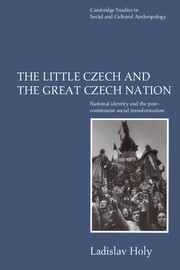 The Little Czech and the Great Czech Nation
The Little Czech and the Great Czech Nation Book contents
- Frontmatter
- Contents
- Acknowledgements
- Introduction
- 1 Nation against state
- 2 Freedom, nation, and personhood
- 3 Self-stereotypes and national traditions
- 4 National traditions and the imagining of the nation
- 5 National traditions and the political process
- 6 Nation and state in the context of Czech culture
- Notes
- References
- Index
2 - Freedom, nation, and personhood
Published online by Cambridge University Press: 05 June 2012
- Frontmatter
- Contents
- Acknowledgements
- Introduction
- 1 Nation against state
- 2 Freedom, nation, and personhood
- 3 Self-stereotypes and national traditions
- 4 National traditions and the imagining of the nation
- 5 National traditions and the political process
- 6 Nation and state in the context of Czech culture
- Notes
- References
- Index
Summary
The demonstrations in Prague in 1988 and 1989 primarily expressed people's strong nationalist sentiments, but the official propaganda was built around their construction as not only anti-socialist but also anti-state actions which the government was obliged to suppress by force. The reason for this was that if the street protests were allowed to continue, nationalist sentiments might evolve into specific political demands which challenged the existing monopoly of power – and this, indeed, is what happened. On 28 October 1989 the demonstrators were already chanting ‘We want another government’ and ‘We want free elections’ and shouting support for Charter 77 and Václav Havel. Many more specific political demands were articulated in the students' demonstration on 17 November. The exceptionally brutal way in which it was suppressed by the police led directly to the continuous mass demonstrations all over Czechoslovakia during which opposition to communist rule crystallised, eventually to bring about sweeping political change. But apart from this politically pragmatic reason, another reason both the demonstrators and the government saw the demonstrations as anti-state acts was that those who represented the state and those who were demonstrating against it shared a single symbolic system.
The central ideological construct or core symbol of a nation enclosed within its own state is ‘freedom’. The calls for freedom were not only calls for the right to express individuality as the basic attribute of a person but also – at least to a certain extent – an invocation of this core symbol.
- Type
- Chapter
- Information
- The Little Czech and the Great Czech NationNational Identity and the Post-Communist Social Transformation, pp. 55 - 71Publisher: Cambridge University PressPrint publication year: 1996
- 1
- Cited by


